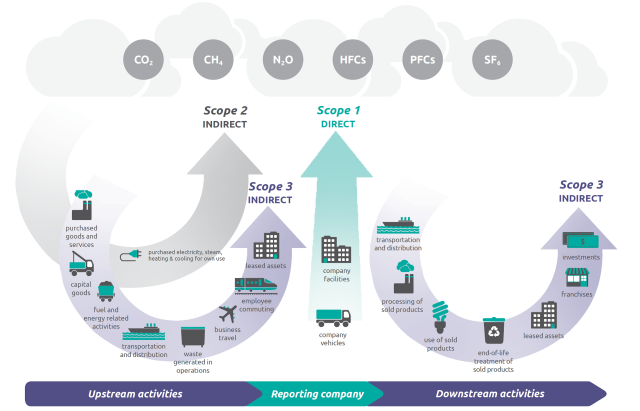Renewable Energy in Corporate Greenhouse Gas Emissions Inventory
- What is a Corporate Greenhouse Gas Emissions Inventory?
- How Does Renewable Electricity Relate to a Corporate Greenhouse Gas Emissions Inventory?
- Additional Resources
What is a Corporate Greenhouse Gas Emissions Inventory?
A corporate greenhouse gas (GHG) inventory is a framework used by organizations to measure and manage GHG emissions associated with their business operations and supply chains. By measuring one’s emissions the organization can better manage them. Organizations develop GHG inventories for a variety of reasons, including:
- Managing climate-related business risks
- Identifying reduction opportunities
- Participating in voluntary or mandatory GHG programs
Organizations around the globe follow standardized methods to list emission sources and their emissions across their operations and value chain. For more information about corporate emissions inventories, standards and practices please see EPA's Center for Corporate Climate Leadership's web area on Greenhouse Gas Inventories.
How Does Renewable Electricity Relate to a Corporate Greenhouse Gas Emissions Inventory?
Electricity is a key part to our daily lives. Electricity use is also a significant source of emissions for many organizations. Therefore, an organization that measures their emissions footprint through a corporate emissions inventory, may choose to address the emissions associated with their electricity use as a key priority.
Within a corporate GHG emissions inventory, emissions are categorized into three different “scopes” or categories. These categories are distinguished based on whether the organization has direct or indirect control over the emissions source. Sources of electricity and the electricity’s emissions can be found in all three scopes or categories of emissions.

Scope 1 emissions are direct GHG emissions that occur from sources that are controlled or owned by an organization (e.g., emissions associated with fuel combustion in boilers, furnaces, vehicles).
Scope 2 emissions are indirect GHG emissions associated with the purchase of electricity, steam, heat, or cooling. Although scope 2 emissions physically occur at a facility where they are generated (usually a power plant owned by a utility), they are accounted for in an organization’s GHG inventory under Scope 2 because they are a result of the organization’s energy use – and the organization having indirect control over emissions source.
Scope 3 emissions are the result of activities from assets not controlled or owned by the reporting organization, but that the organization indirectly impacts in its value chain. Some organizations may purchase renewable electricity for a narrow set of scope 3 emissions sources to reduce the organization’s emissions footprint, for example, purchasing renewable electricity for the electricity use of a manufacturer’s products in the market.
Additional Resources
- EPA’s Center for Corporate Climate Leadership - serves as a resource center for all organizations looking to expand their work in the area of greenhouse gas (GHG) measurement and management
- EPA Scope 1 and Scope 2 Inventory Guidance
- Renewable Electricity Procurement on Behalf of Others: A Corporate Reporting Guide (pdf) - is a U.S. practice paper in response to the growing interest in accounting for renewable electricity use across corporate value chains to address scope 3 emissions.
- Renewable Electricity Procurement for Use of Sold Products (pdf) – is a U.S. practice paper that discusses how renewable electricity procurement may help reporting organizations reduce their scope 3, category 11 GHG emissions that result from the use of sold products that consume electricity.
- Guide to Purchasing Green Power – this guide provides information about buying and using green power
- Renewable Energy Project Development Resource Directory – This tool provides a wide range of resources related to renewable electricity procurement and best practice
Listing of resources do not constitute EPA endorsement of the following organizations or their products, services, or resources:
- World Resource Institute and World Business Council for Sustainable Development’s Greenhouse Gas Protocol
